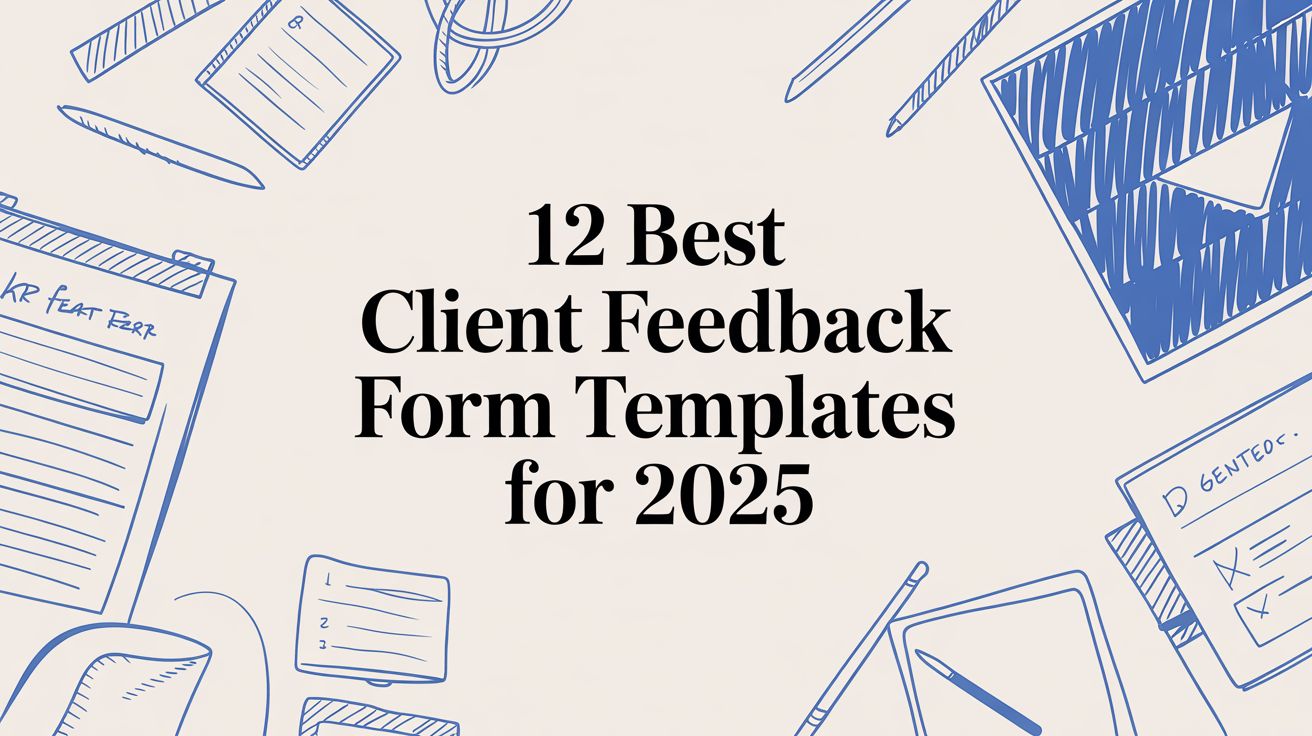Gathering client feedback is not just a procedural step; it’s the core mechanism for innovation and client retention. In fact, businesses that actively seek and act on customer feedback can increase their revenues by 84%. Yet, the quality of your feedback is directly tied to the quality of your collection method. A poorly designed or generic form yields vague answers, suffers from low completion rates—sometimes as low as 10-30%—and results in missed opportunities to improve.
This guide eliminates the guesswork. We have curated and analyzed the 12 best sources for client feedback form templates, from simple free tools like Google Forms to sophisticated platforms like Typeform and Jotform. For each option, we provide a concise analysis, screenshots, direct links, and ideal use cases to help you choose the right tool for your specific needs.
Whether you’re a solo developer refining a feature, an agency managing multiple projects, or an engineering manager aiming to streamline communication, the right template is critical. It transforms feedback from a simple Q&A into a strategic asset that drives your projects forward with clarity and precision. Find the perfect fit for your workflow and start gathering insights that matter.
1. Typeform
Typeform stands out by transforming standard forms into engaging, conversational experiences. Instead of overwhelming users with a long list of questions, it presents them one at a time, a method proven to boost completion rates. This makes it an excellent choice for gathering detailed client feedback without causing survey fatigue. Their templates are not just functional; they are beautifully designed and highly customizable to match your brand’s aesthetic.
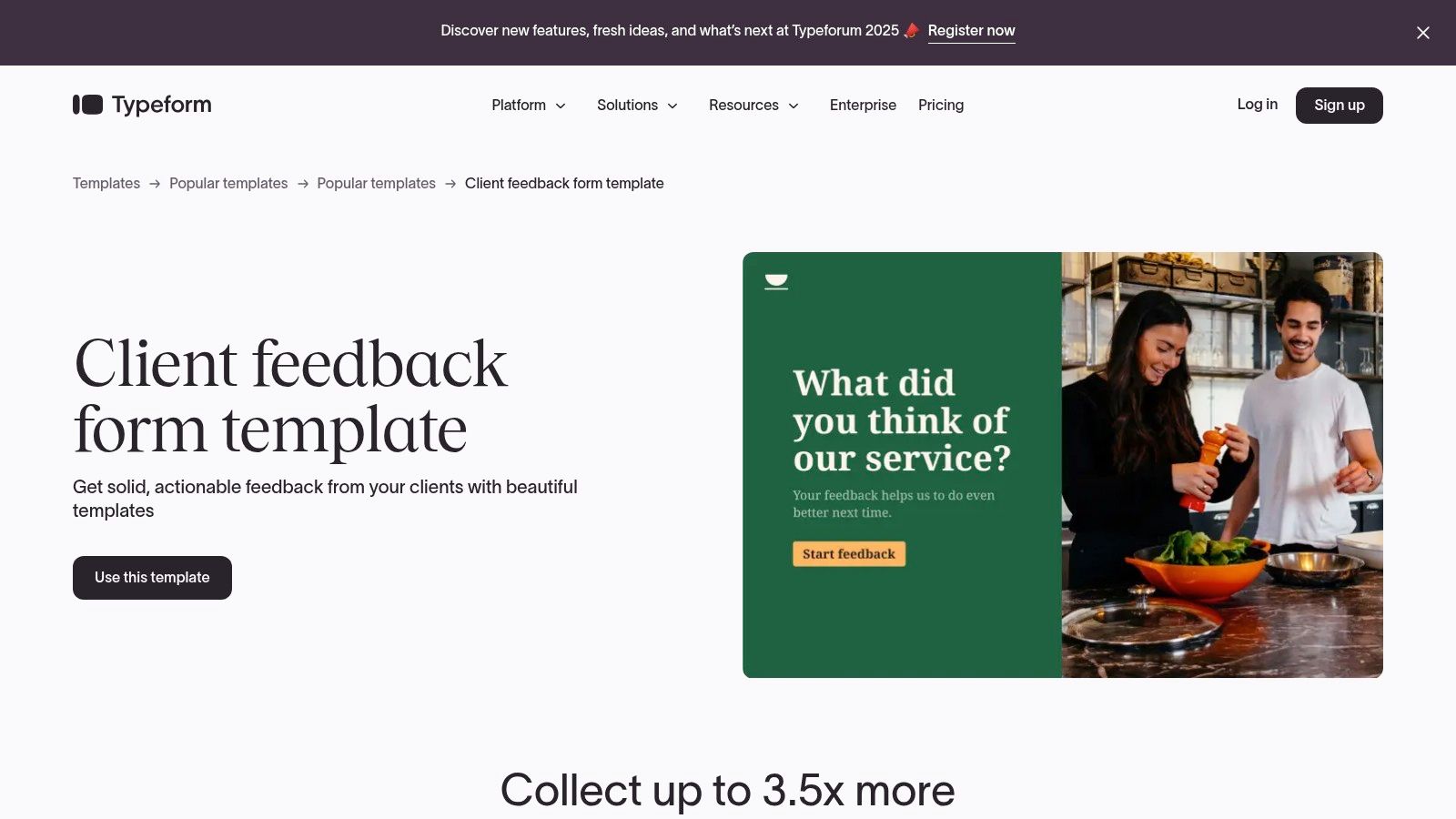
This platform is ideal for tech professionals who need to integrate feedback directly into their development lifecycle. With over 300 integrations, including Slack, HubSpot, and Zapier, you can automatically create a new ticket in Jira or send a notification to a project channel based on a client’s response. This automation streamlines the process of acting on feedback, ensuring client insights directly inform your next sprint.
The free plan offers a solid starting point, but for advanced features like logic jumps, unlimited questions, or higher response limits, a paid plan is necessary.
Key Highlights:
-
Conversational Interface: Presents one question at a time to keep users engaged.
-
Powerful Integrations: Connects feedback to tools like Jira, Slack, and Trello.
-
High Customization: Offers extensive control over design and branding.
-
Limitations: Advanced logic and higher response volumes require a subscription.
Website: Typeform Client Feedback Form Template
2. Jotform
Jotform is a powerhouse for anyone needing a client feedback form template quickly and without a steep learning curve. It offers one of the largest libraries available, with thousands of ready-made templates categorized for specific needs like NPS, service reviews, and even cancellation feedback. Its user-friendly drag-and-drop editor makes it exceptionally approachable for non-technical team members who need to create and deploy forms without writing a single line of code.
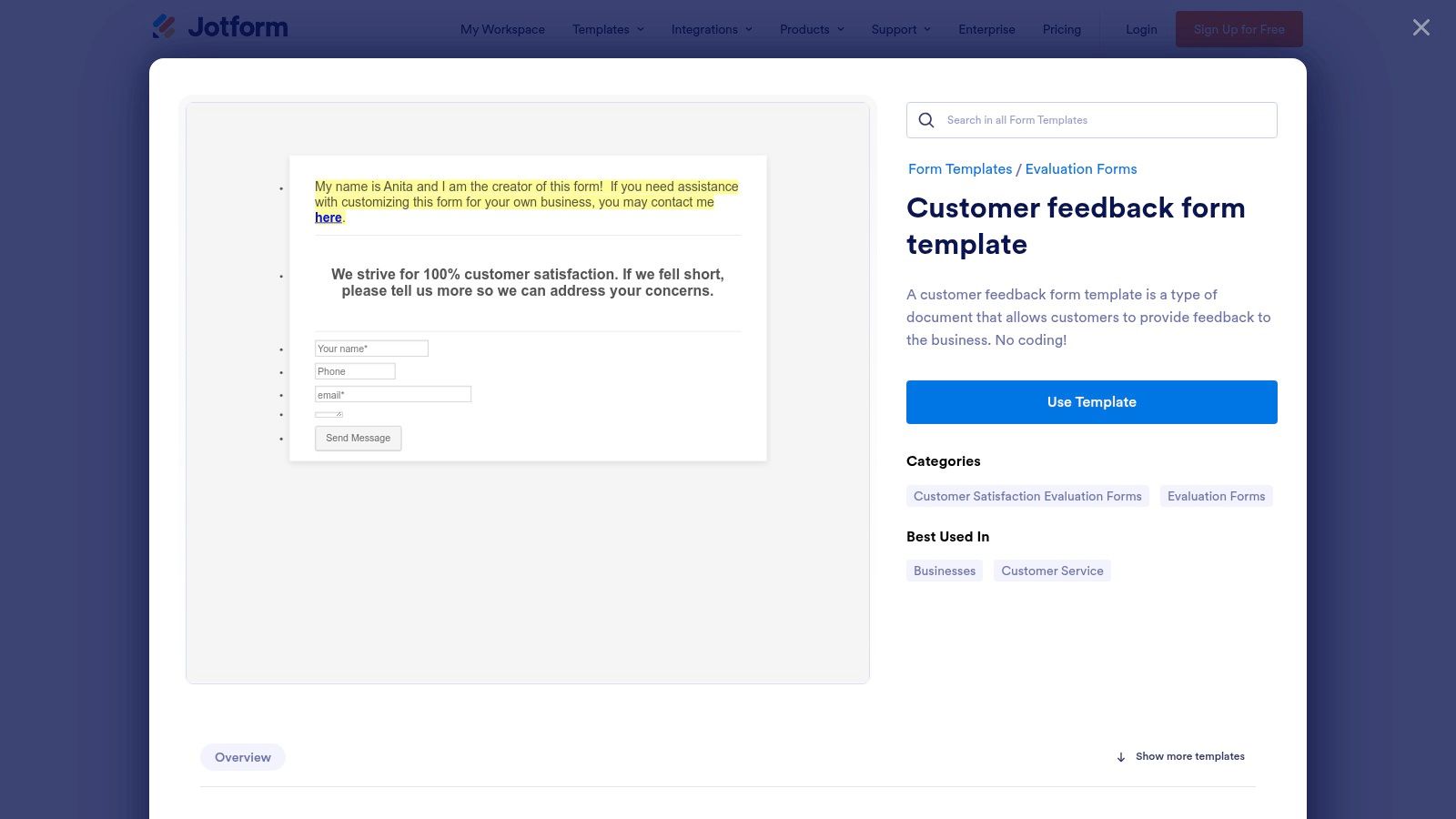
This platform excels at simplifying data collection and reporting. With over 100 integrations, you can automatically send feedback submissions to Google Drive, Dropbox, or your CRM. The built-in reporting tools and e-signature support make it a versatile choice for teams that need to formalize client sign-offs or analyze response trends directly within the platform. This makes it ideal for projects where speed and ease of use are more critical than complex, custom-coded integrations.
The free plan is generous for small-scale projects, but more advanced features like conditional logic, higher submission limits, and complex automations are reserved for paid tiers.
Key Highlights:
-
Extensive Template Library: Provides a vast selection of pre-built forms for any use case.
-
Drag-and-Drop Builder: An intuitive interface makes form creation accessible to everyone.
-
Built-in Reporting: Easily analyze and export client feedback data.
-
Limitations: Sophisticated automation and removing Jotform branding require a paid plan.
Website: Jotform Customer Feedback Form Template
3. SurveyMonkey
SurveyMonkey is a powerhouse in the survey world, offering a vast library of expert-written templates designed for comprehensive data collection. Its strength lies in providing structured, methodologically sound client feedback form templates, including options for customer satisfaction, support interactions, and testimonial gathering. This makes it an excellent choice for organizations that need to go beyond simple feedback and perform robust data analysis.
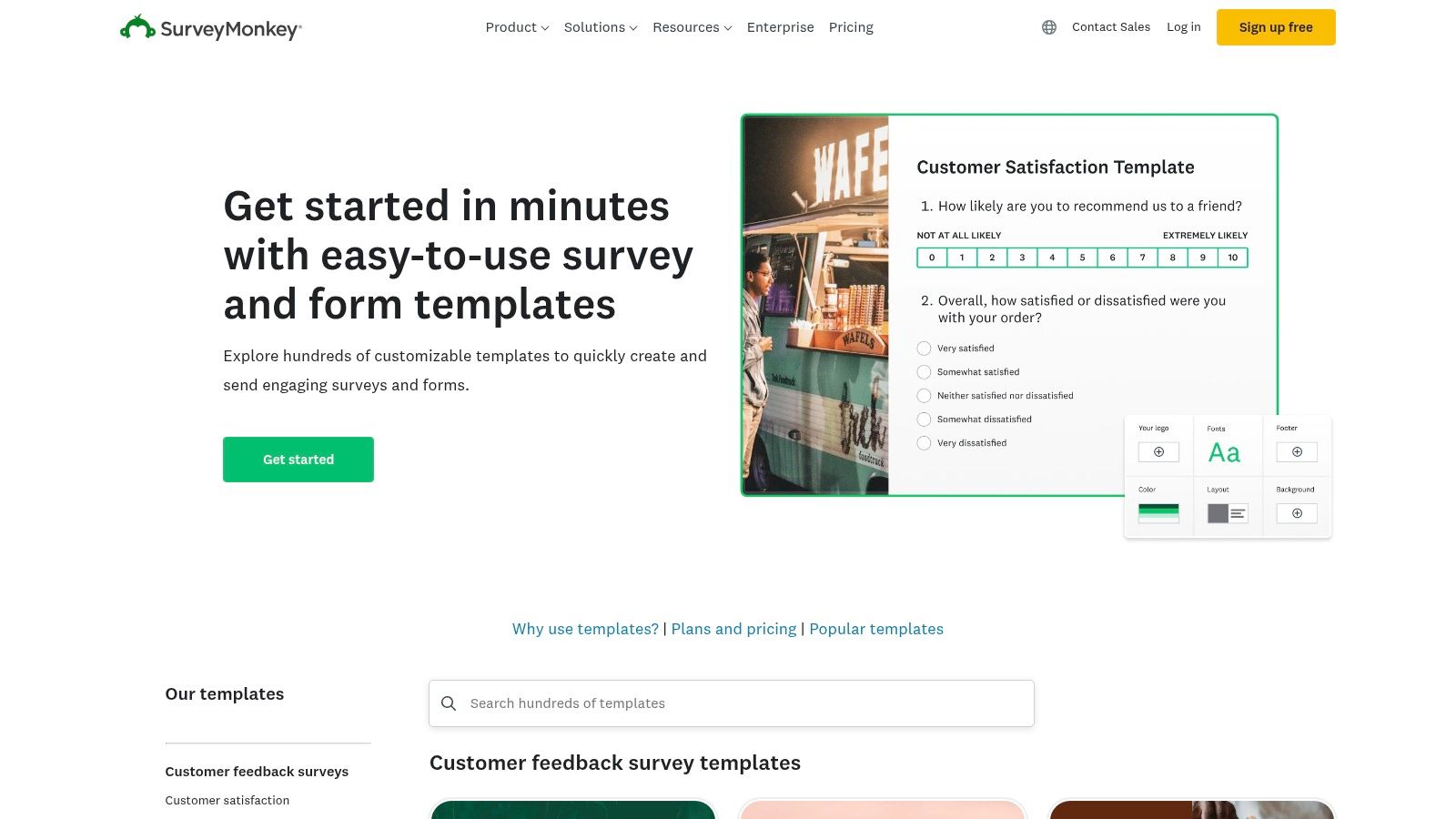
This platform is particularly well-suited for engineering managers and technical leads who require quantitative data to justify product decisions. The pre-built question banks and survey logic ensure you’re asking the right questions, while the powerful analytics suite allows you to slice, dice, and benchmark responses against industry standards. You can easily share your survey via email, direct link, or by embedding it directly into your application.
While the free plan offers basic functionality, many of the features that make SurveyMonkey a top contender, like advanced analysis, custom branding, and data exports, are locked behind a subscription.
Key Highlights:
-
Expert Templates: Utilizes professionally designed templates aligned with established CX frameworks.
-
Robust Analytics: Offers powerful tools for analyzing trends, filtering results, and creating reports.
-
Question Bank: Provides access to a library of certified questions to build effective surveys quickly.
-
Limitations: The most valuable analysis and customization features require a paid plan.
Website: SurveyMonkey Templates
4. Google Forms
Google Forms is an accessible and straightforward tool for creating effective client feedback forms at no cost. Its main advantage lies in its seamless integration with the Google Workspace ecosystem, making it an excellent choice for teams already using tools like Gmail, Drive, and Sheets. The platform offers a variety of basic templates, allowing you to deploy a functional feedback mechanism in minutes without any financial investment.
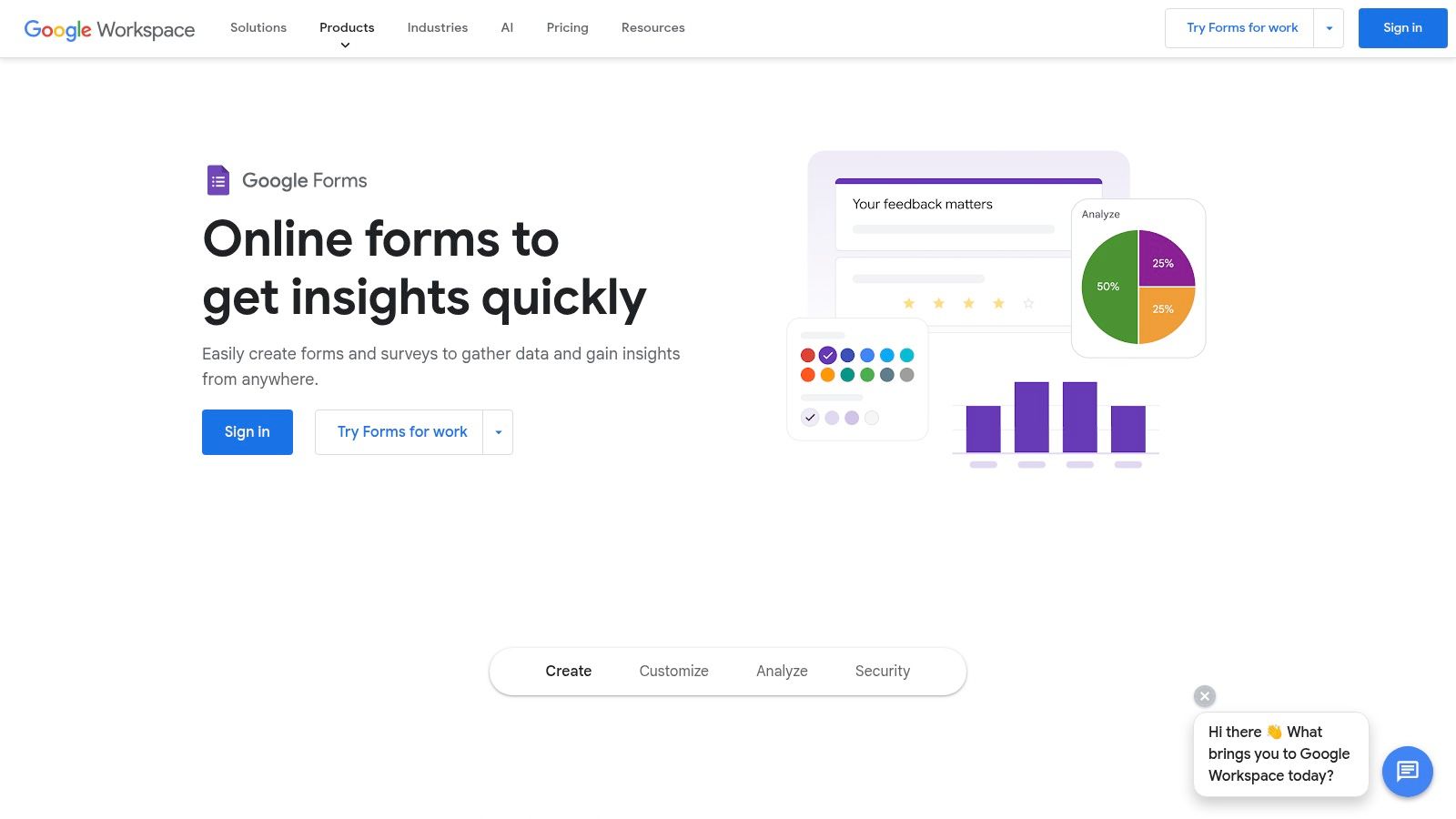
This platform is particularly useful for developers and small teams needing a quick, data-centric feedback solution. All responses are automatically collected in a Google Sheet in real-time, providing an organized and easily analyzable dataset. You can set up notifications for new responses and even use Google Apps Script to build custom workflows, such as automatically creating a task in a project management spreadsheet when negative feedback is received. This direct data pipeline is powerful for teams who prefer to manage their feedback loop within a spreadsheet environment.
While free and highly functional, Google Forms offers limited design customization and lacks the advanced conditional logic found in more specialized platforms.
Key Highlights:
-
Completely Free: No cost for creating forms or collecting responses.
-
Google Sheets Integration: Automatically sends all feedback data to a spreadsheet for easy analysis.
-
Simple and Fast: Create and share a professional client feedback form template in minutes.
-
Limitations: Lacks advanced branding options and sophisticated analytical features.
Website: Google Forms
5. Microsoft Forms (via Microsoft Create)
For organizations deeply embedded in the Microsoft 365 ecosystem, Microsoft Forms offers a seamless and straightforward solution. Accessed via Microsoft Create, its curated template library provides a solid starting point for various feedback scenarios. Instead of building from scratch, you can select a pre-designed client feedback form template and customize it directly within the familiar Forms interface.
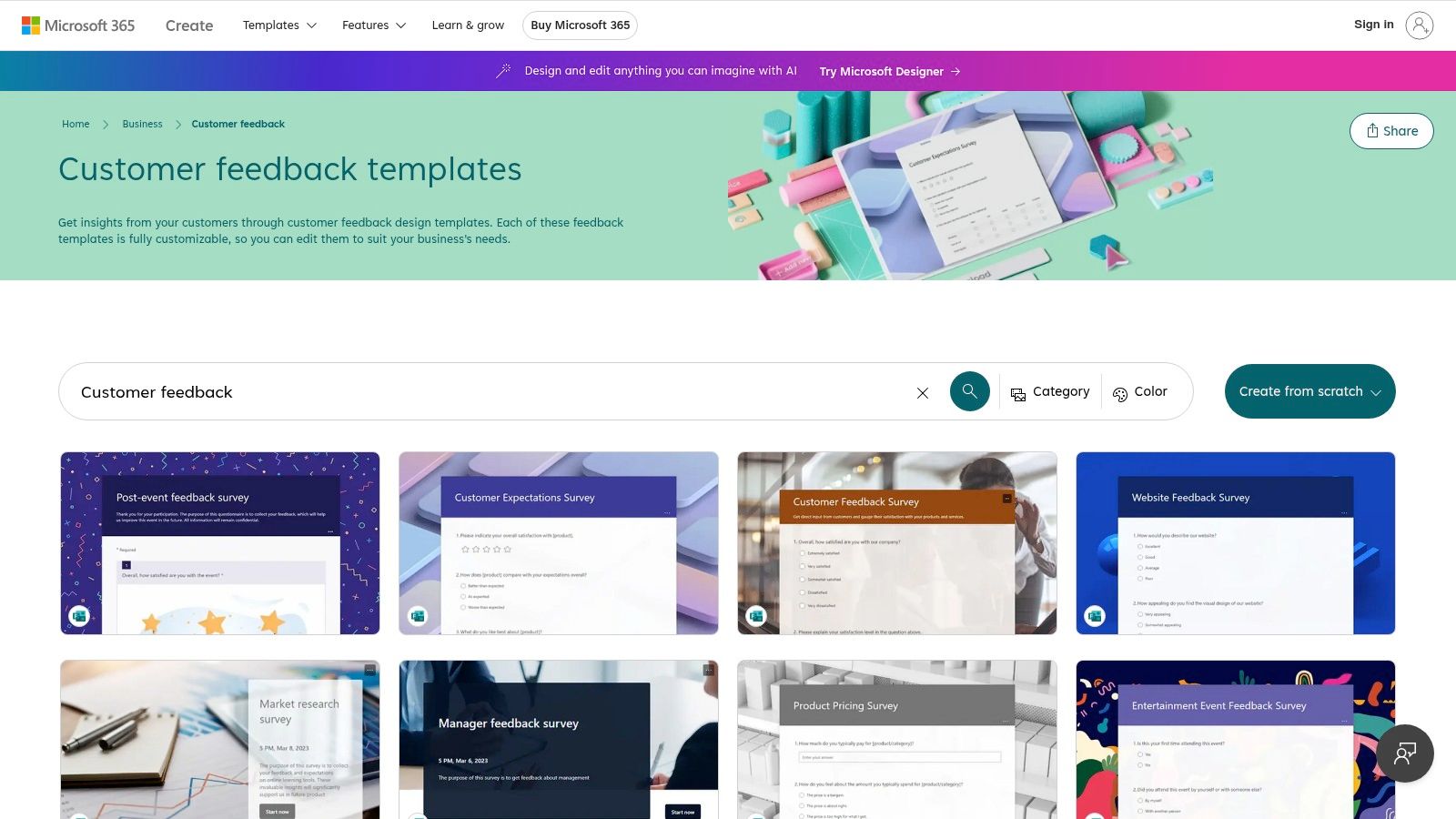
This platform is particularly useful for tech teams that rely on Office applications for data analysis and reporting. The standout feature is its native integration with Excel; all responses can be exported into a spreadsheet with a single click, allowing for easy sorting, filtering, and pivot table creation. This simplifies the process of analyzing quantitative feedback and identifying trends without needing third-party tools or complex data migrations.
While it lacks the advanced design flourishes of competitors, its value lies in its simplicity and deep integration. Microsoft Forms is typically included with Microsoft 365 subscriptions, making it a cost-effective choice for existing users.
Key Highlights:
-
Deep M365 Integration: Works flawlessly with other Microsoft tools like Excel and SharePoint.
-
Simple Interface: Easy to create, share, and analyze forms without a steep learning curve.
-
One-Click Excel Export: Instantly sends all response data to a spreadsheet for analysis.
-
Limitations: Customization options are basic, and the template selection is more limited than dedicated platforms.
Website: Microsoft Forms Customer Feedback Templates
6. Canva
Canva is primarily a design platform, but it offers a unique approach to creating visually stunning client feedback forms. Instead of focusing on complex logic and data analysis, Canva excels at producing beautifully designed questionnaires that perfectly match your brand’s aesthetic. This makes it ideal for when the presentation and visual impact of your feedback form are just as important as the questions themselves. You can share your creation as a printable PDF, a digital link, or even embed it on a website.
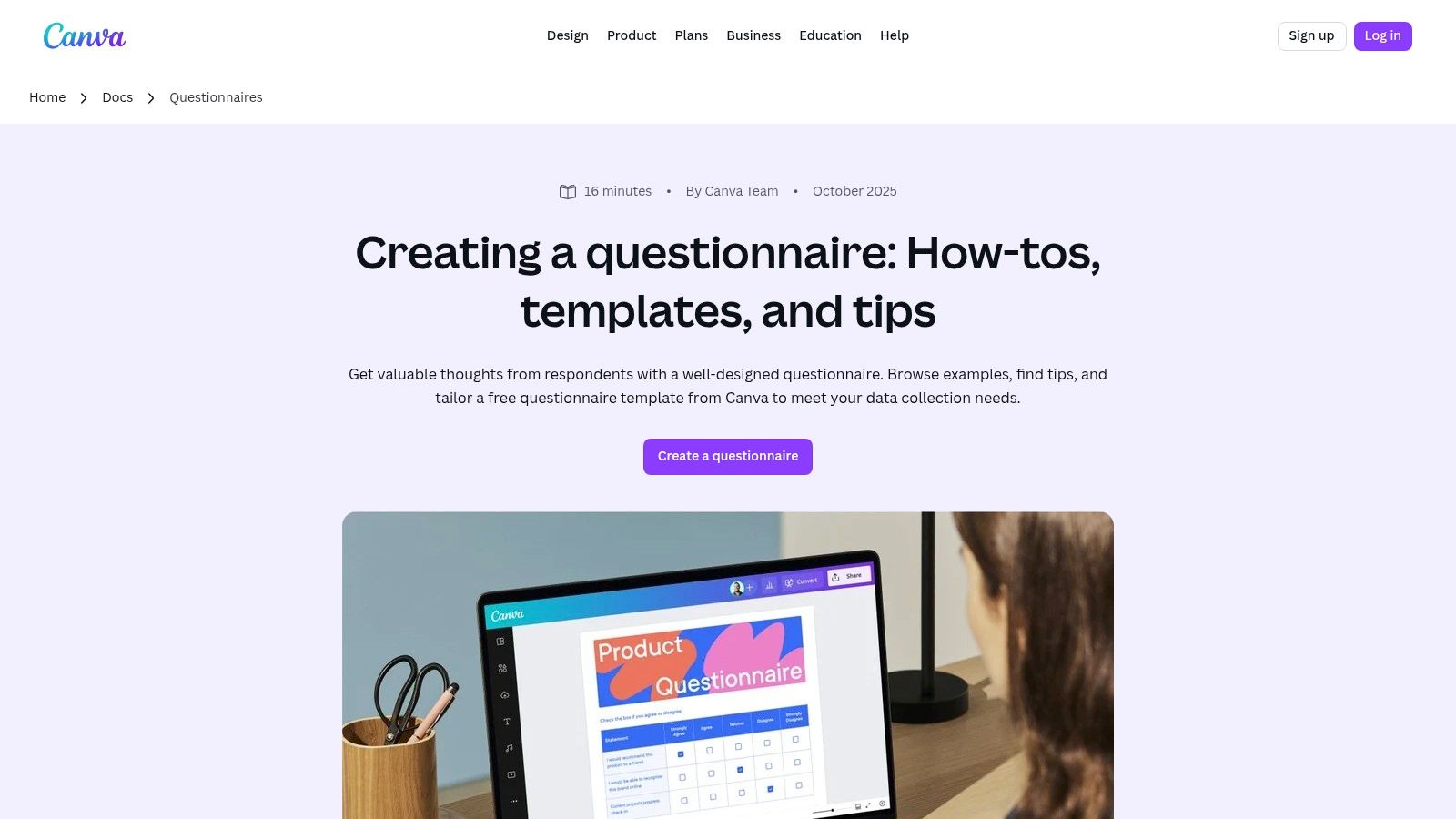
This platform is a great choice for creative agencies, freelancers, and businesses that need to maintain strong brand consistency across all client touchpoints, including feedback collection. For example, a design firm could create an on-brand, printable comment card for an in-person workshop or a stylish digital form to send after a project milestone. While it lacks the automated data collection of dedicated survey tools, its strength lies in design flexibility and ease of use, allowing anyone to produce professional-quality documents without needing design skills.
The free version provides access to thousands of templates, while a Pro subscription unlocks premium assets and more advanced features.
Key Highlights:
-
Strong Visual Control: Unmatched customization to create on-brand, designer-quality forms.
-
Versatile Sharing Options: Share as a live link, embed, or export as a high-quality PDF for printing.
-
Large Template Library: Access a massive collection of pre-made questionnaire and survey layouts.
-
Limitations: Not a true survey tool; lacks conditional logic and automated data analysis features.
Website: Canva Docs & Questionnaires
7. Smartsheet
Smartsheet offers a unique, spreadsheet-centric approach to collecting client feedback. It provides free, downloadable client feedback form templates in familiar formats like Excel and PDF, making it an excellent starting point for teams comfortable with spreadsheet-based workflows. These templates come with helpful guidance and best-practice tips, ensuring you ask the right questions from the get-go.
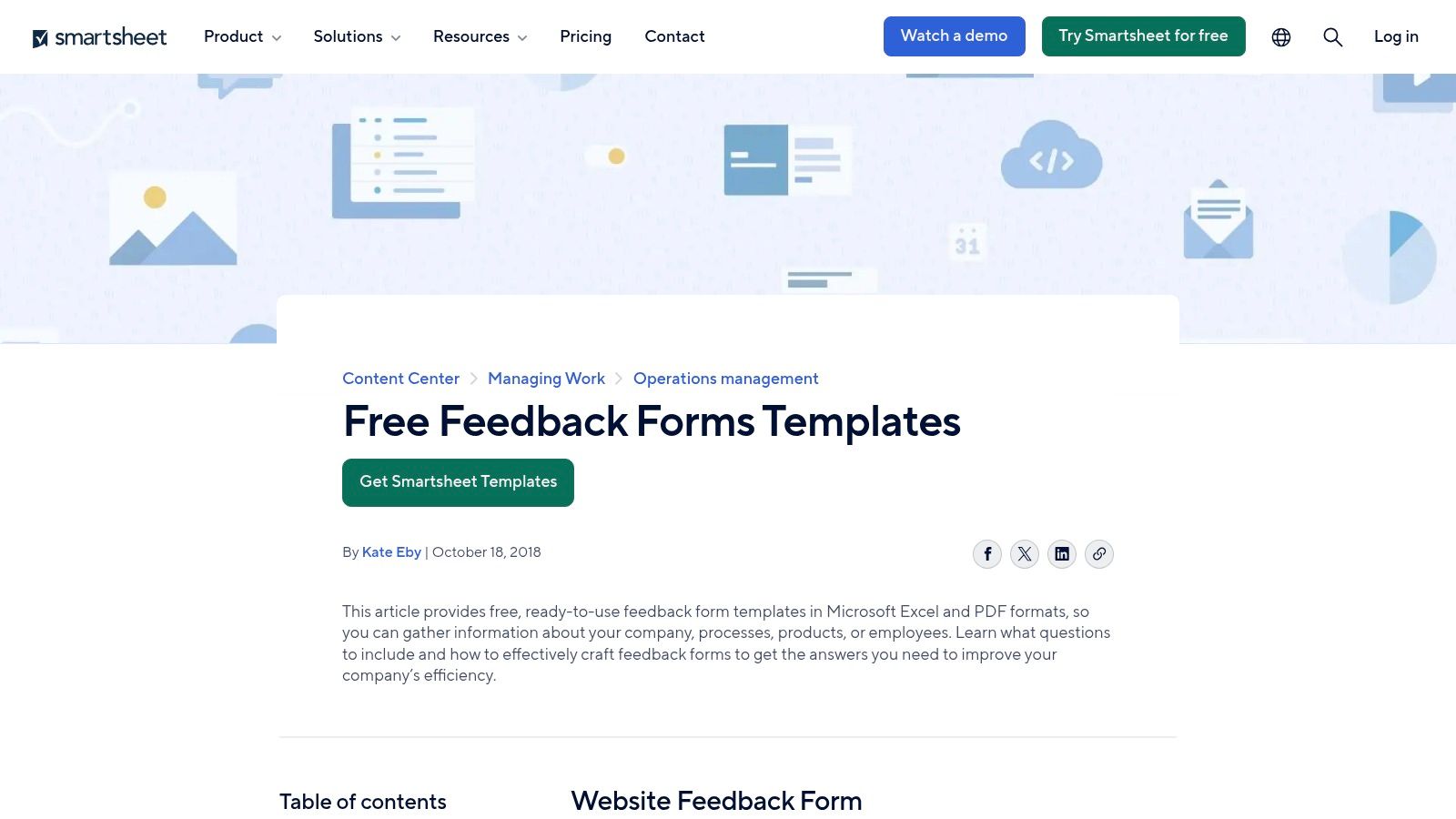
This platform is particularly beneficial for engineering managers and technical leads who need to transition from manual data collection to a more structured reporting system. Once you’re ready to move beyond static files, you can build live web forms directly within Smartsheet. This allows client responses to populate a sheet in real-time, creating a centralized database for feedback analysis and action planning, similar to how a well-structured product design specification template organizes project requirements.
While the downloadable templates are free, you are responsible for their distribution and collection. To use the integrated web forms for live data collection and reporting, a Smartsheet subscription is required.
Key Highlights:
-
Downloadable Templates: Offers free, ready-to-use feedback forms in Excel and PDF.
-
Spreadsheet Integration: Ideal for teams that manage projects and data in spreadsheets.
-
Structured Reporting: Web forms feed directly into Smartsheet for easy analysis.
-
Limitations: Downloaded templates require manual distribution; web forms need a paid plan.
Website: Smartsheet Feedback Forms Templates
8. Formstack
Formstack is a powerful tool designed for teams that need more than just a simple feedback form; they need a complete data management workflow. It excels at collecting client feedback and then automatically routing that information to the right people or systems. Using a drag-and-drop builder, you can easily create sophisticated forms with conditional logic, ensuring clients only see relevant questions. This makes it a great choice for gathering nuanced feedback on complex projects.
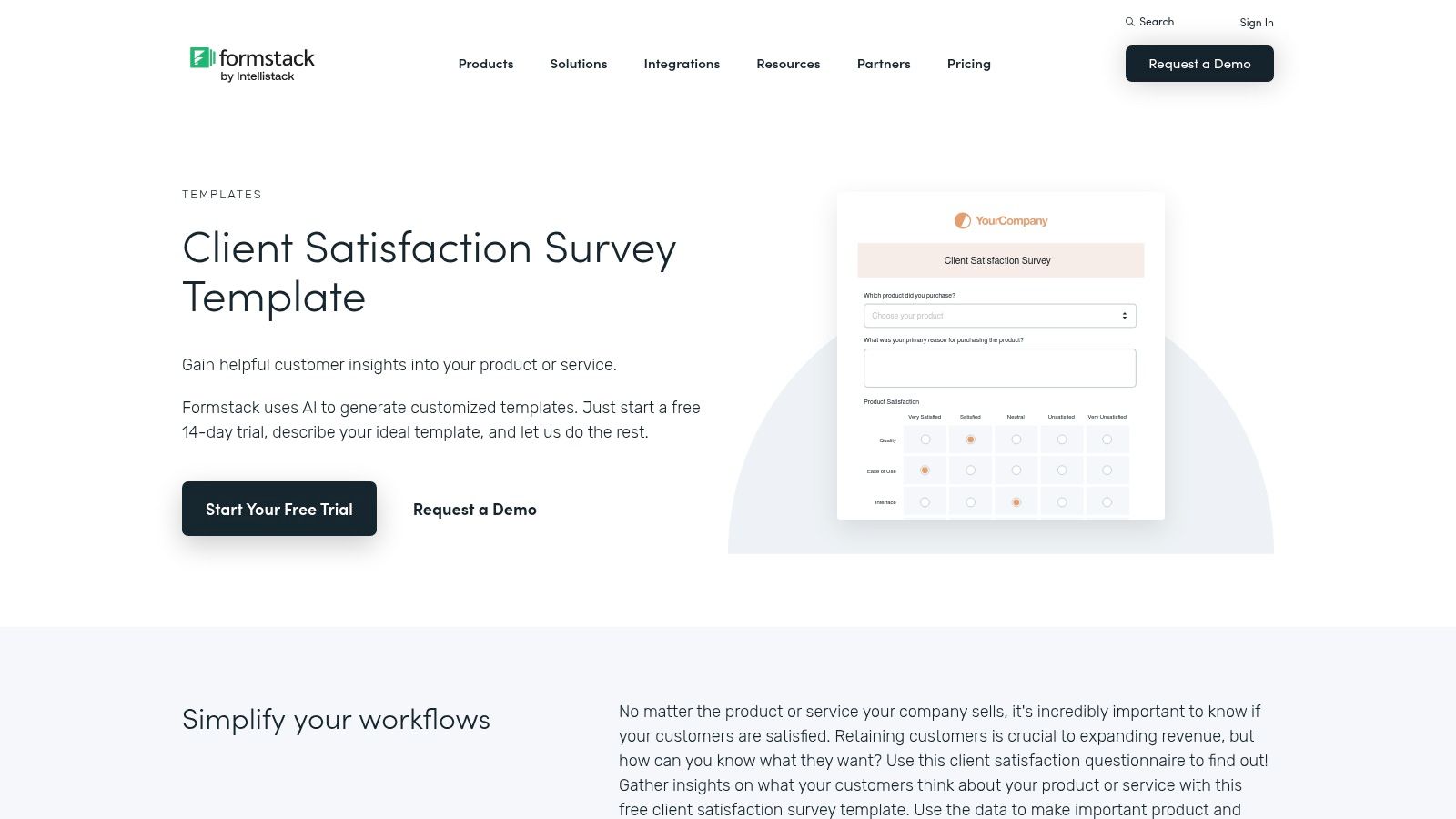
This platform is particularly well-suited for engineering teams in regulated industries or large organizations that require robust data handling and compliance. Its suite of tools allows you to create detailed client feedback form templates that can trigger specific workflows, such as notifying an account manager of a negative review or creating a support ticket in a CRM. With strong enterprise-level integrations, it ensures feedback is not just collected but acted upon systemically.
While Formstack offers a 14-day trial, ongoing use requires a paid plan, which can be more expensive than simpler form builders on the market.
Key Highlights:
-
Workflow Automation: Strong data routing and follow-up capabilities.
-
Drag-and-Drop Builder: Easily create complex forms with conditional logic.
-
Enterprise-Ready: Offers robust integrations and compliance features.
-
Limitations: No free plan available after the trial period; can be costly for smaller teams.
Website: Formstack Client Satisfaction Survey
9. HubSpot (blog and template pack)
For businesses already embedded in the HubSpot ecosystem, their collection of feedback form resources is an invaluable asset. Rather than just offering a standalone tool, HubSpot provides a free downloadable pack with five distinct client feedback form templates, complete with examples and best practices. This approach is perfect for teams who want to align their feedback collection directly with their CRM data and customer success workflows, ensuring every piece of insight is actionable.
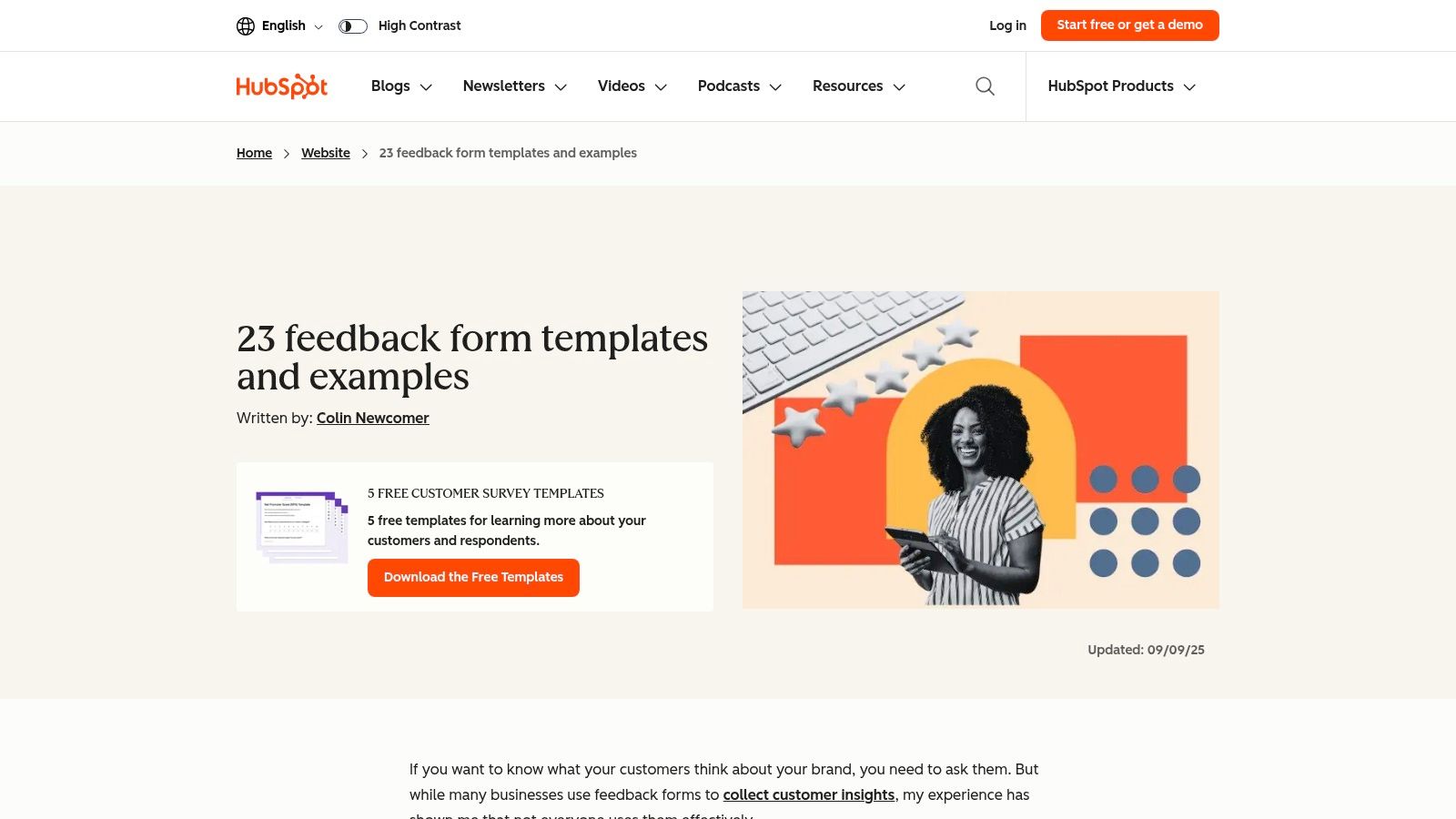
The true power of using HubSpot for feedback lies in its native integration with the Service Hub and CRM. You can build feedback surveys directly within the platform, automatically trigger them after a support ticket is closed, and tie responses to specific customer records. This creates a unified view of the customer journey, turning qualitative feedback into quantitative data that can inform everything from marketing campaigns to product development. This level of integration is essential for turning raw client feedback into a well-defined product requirements document, a process that ensures customer needs are accurately translated into engineering tasks.
While the template pack and basic forms are free, unlocking full automation, advanced reporting, and deeper integrations requires a subscription to HubSpot’s Service Hub Pro or Enterprise tiers.
Key Highlights:
-
CRM Integration: Directly connects feedback responses to customer profiles in HubSpot CRM.
-
Actionable Templates: Offers a free downloadable pack with practical templates and examples.
-
Workflow Automation: Triggers surveys based on customer actions within the HubSpot ecosystem.
-
Limitations: Advanced features and full automation are locked behind paid Service Hub plans.
Website: HubSpot Feedback Form Template
10. Template.net
Template.net serves a different need by providing a vast library of downloadable and editable client feedback form templates in various file formats. Unlike online form builders, its strength lies in offering documents compatible with familiar software like Word, Google Docs, PDF, and Sheets. This makes it a go-to resource when you need printable forms for in-person consultations or document-based workflows where digital signatures are common.
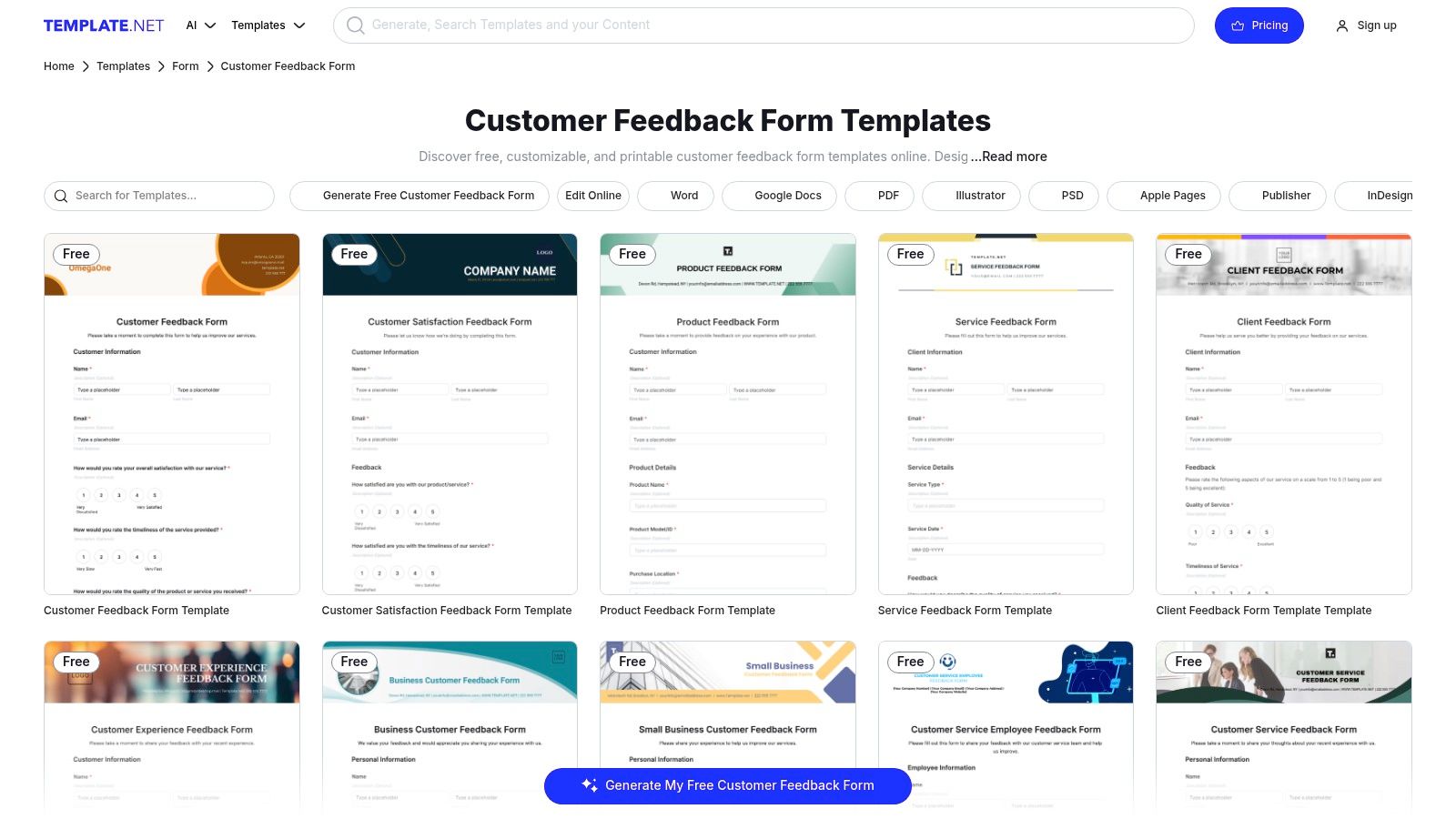
This platform is particularly useful for freelance developers or agencies that need industry-specific wording right out of the box. You can find templates tailored for software projects, web design feedback, or IT service reviews, saving you the time of drafting questions from scratch. The ability to download a file and tweak it offline in a program you already master offers a straightforward, no-frills approach to feedback collection.
While many templates are free, the highest-quality and most specialized designs often require a premium subscription. The quality can also vary, as it’s a marketplace with multiple contributors.
Key Highlights:
-
Multiple File Formats: Download templates for Word, Google Docs, Sheets, PDF, and more.
-
Industry-Specific Designs: Offers a wide variety of niche-specific client feedback form templates.
-
Printable & Offline Use: Ideal for workflows that require physical copies or offline editing.
-
Limitations: Premium templates are behind a paywall, and design quality can be inconsistent.
Website: Template.net Customer Feedback Forms
11. Airtable
Airtable elevates client feedback form templates from simple data collection tools into powerful, structured databases. It excels at turning raw feedback into actionable insights by allowing you to create form views that feed directly into a customizable base. This approach is perfect for teams that need to not just gather, but also analyze, categorize, and track feedback over time.
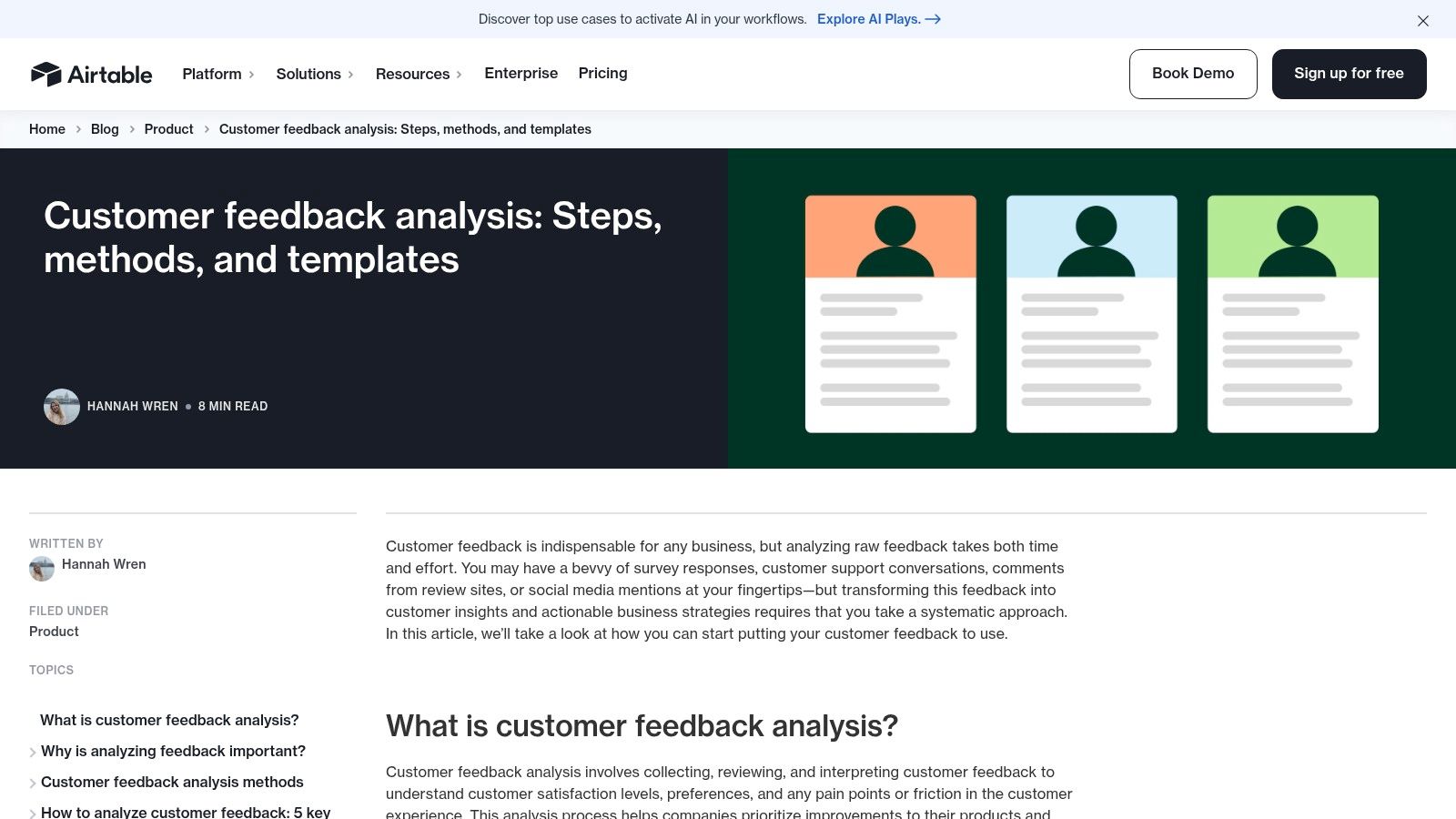
This platform is particularly valuable for product and development teams who need to manage feedback at scale. Using Airtable’s AI capabilities, you can automatically perform sentiment analysis or tag responses by theme, which helps in prioritizing features and bug fixes. For technical leads, this structured data is essential for translating customer needs into clear product requirements . The ability to build custom dashboards provides a clear, at-a-glance view of customer satisfaction metrics like CSAT and NPS.
While the initial setup is more involved than a simple survey tool, the long-term benefits of a centralized, organized feedback system are significant. The free plan has limitations on base size, so larger projects may require a paid subscription.
Key Highlights:
-
Structured Data Collection: Form views feed directly into a flexible database.
-
AI-Powered Analysis: Automates sentiment analysis and categorization of feedback.
-
Custom Dashboards: Visualize key feedback metrics and trends.
-
Limitations: Steeper learning curve than basic form builders; free plan has record limits.
Website: Airtable Customer Feedback Analysis
12. Tally
Tally positions itself as a refreshingly simple and powerful alternative to traditional form builders, often described as the “Notion of forms.” Its unique approach allows users to build forms as easily as writing a document, making it incredibly fast for creating client feedback form templates. This platform is perfect for developers and startups who need a functional, no-fuss solution without a steep learning curve or high cost.
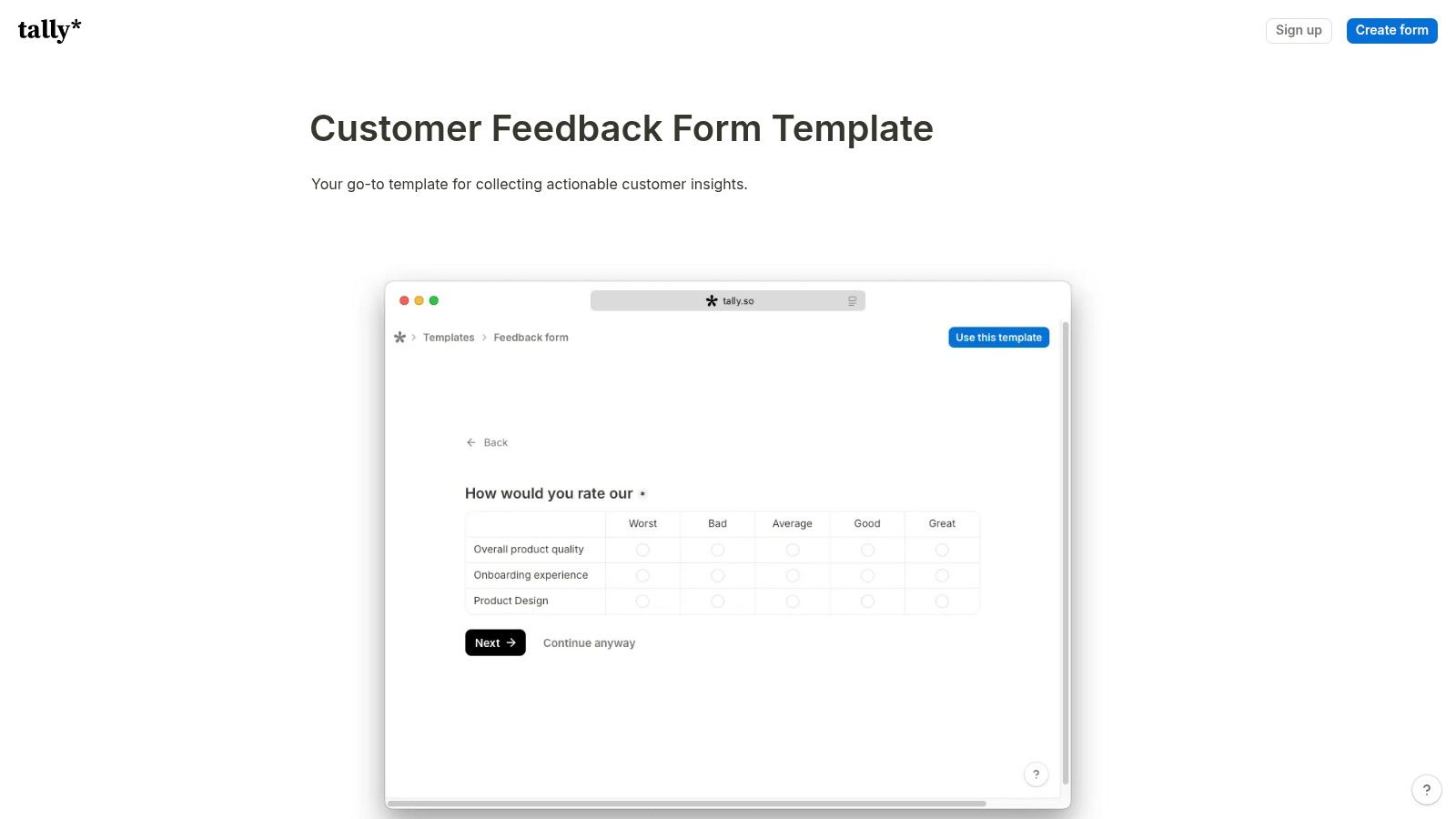
What makes Tally stand out is its exceptionally generous free plan, which offers unlimited forms and submissions, along with features like conditional logic that are often paywalled elsewhere. This allows even small teams or solo developers to gather sophisticated feedback. Its integrations with tools like Notion and Airtable are seamless, enabling engineers to pipe client feedback directly into their project management or database systems, turning qualitative data into actionable tasks effortlessly.
For those needing more advanced features like custom branding or team collaboration, the Pro plan is available, but the free version covers 99% of common use cases.
Key Highlights:
-
Generous Free Plan: Offers unlimited forms, questions, and submissions for free.
-
Simple Interface: Building forms feels as intuitive as typing in a doc.
-
Key Integrations: Connects directly with Notion, Airtable, and Mailchimp.
-
Limitations: Analytics are less robust compared to enterprise-focused platforms.
Website: Tally Customer Feedback Form Template
Top 12 Client Feedback Form Template Comparison
Product | Core features | Best for (Target audience) | Unique selling point | Pricing note |
|---|---|---|---|---|
Typeform | Conversational one-at-a-time UI; logic jumps; 300+ integrations; templates | Marketing teams, customer feedback with high completion goals | Engaging, design-forward UX that boosts response rates | Free limited; advanced features on paid plans |
Jotform | Drag-and-drop builder; conditional logic; large template library; exports | Non-technical users needing ready templates and reports | Approachable builder + generous free tier | Free tier; paid for higher limits and automations |
SurveyMonkey | Prebuilt question banks; advanced survey logic; analytics & benchmarking | Organizations needing robust analysis and CX benchmarking | Strong analytics and expert-backed templates | Many analytics/export features require paid plans |
Google Forms | Simple forms; Sheets export; basic conditional logic; real-time charts | Fast deployment and Google Workspace teams | Free and seamless Google Sheets integration | Free (Workspace may add admin controls) |
Microsoft Forms | Click-to-start templates; Excel export; Office 365 integration; anonymous responses | Microsoft 365 organizations | Native Office/Excel integration for easy analysis | Included with Microsoft 365; basic free use |
Canva | Designer templates; visual customization; collaboration; PDF/embed exports | Teams prioritizing strong visual branding and print-ready forms | High design control without needing a designer | Free tier; premium assets/features paid |
Smartsheet | Downloadable Excel/PDF templates; web forms; guidance; reporting path | Spreadsheet-centric workflows and structured reporting | Spreadsheet-first templates with route to Smartsheet reporting | Templates free; web forms require Smartsheet plan |
Formstack | Drag-and-drop; conditional logic; data routing; reporting; enterprise integrations | Teams needing routed workflows and enterprise integrations | Strong workflow and data-routing tools for follow-ups | 14-day trial; paid plans required |
HubSpot (templates) | Template pack + how-tos; CRM integrations; Service Hub guidance | Organizations using HubSpot CRM and Service Hub | Templates tied to CRM workflows and customer success | Templates/free resources; automation requires paid HubSpot tiers |
Template.net | Industry-specific templates in Word/Sheets/PDF/Forms; editable online | Niche-specific or printable/document-based workflows | Wide file-format options and industry-focused templates | Mix of free and paid; subscription for full access |
Airtable | Form views into bases; AI categorization; dashboards; automations | Product and ops teams turning feedback into structured data | Flexible bases + AI-assisted analysis and dashboards | Free tier with limits; paid for larger bases/features |
Tally | No‑code builder; conditional logic; embeds; integrations; file uploads | Quick, lightweight feedback with unlimited forms on free plan | Very generous free plan and ultra-fast setup | Generous free plan; Pro unlocks branding/advanced features |
From Feedback to Features: Turn Insights Into Action
You now have a comprehensive toolkit of 12 powerful platforms, each offering a unique set of client feedback form templates to capture valuable user insights. From the sleek, conversational style of Typeform to the sheer utility of Google Forms and the advanced workflow automation of Smartsheet, the perfect starting point for your feedback loop is within reach. We’ve explored how these tools can serve specific needs, whether you’re conducting a quick post-launch survey, gathering detailed bug reports, or running an in-depth Net Promoter Score (NPS) campaign.
The key takeaway is that no single template fits every scenario. Your choice depends entirely on your project’s stage, your team’s technical comfort, and the depth of information you need. A simple Google Form might be perfect for an indie developer validating an idea, while an enterprise team might leverage HubSpot’s integrated CRM capabilities to tie feedback directly to customer profiles.
Making Your Selection: Key Considerations
Before you commit, reflect on these critical factors:
-
Integration is Everything: How will this tool fit into your existing workflow? Consider integrations with project management tools like Jira, communication platforms like Slack, or data warehouses for deeper analysis. A form that lives in a silo is a missed opportunity.
-
Scalability for Growth: The template that works for your first 100 users might not scale to 10,000. Think about future needs like advanced analytics, conditional logic, and API access. Platforms like Jotform and Formstack offer robust features that can grow with you.
-
The User Experience (UX): Remember, the form itself is a user touchpoint. A clunky, confusing, or poorly designed form can deter clients from providing the very feedback you need. Prioritize tools like Typeform or Tally that offer a clean, engaging user experience.
The Real Challenge: From Raw Feedback to Actionable Code
Choosing the right client feedback form templates is the first step. The real challenge, where 70% of engineering rework stems from, is translating raw, often ambiguous client feedback into precise, actionable engineering tasks. A client might say, “I wish the dashboard loaded faster,” but what does that mean in terms of code? This is where the process often breaks down, leading to misinterpreted requirements, wasted development cycles, and frustrating rework.
This is where a structured, context-aware process becomes indispensable. Vague requests fed to AI coding assistants can result in “hallucinated” code that doesn’t align with your existing architecture. The crucial missing piece is the bridge between human language and your project’s specific codebase.
Tools like the Context Engineer MCP (Model Context Protocol) are transformative. The MCP analyzes your IDE and entire codebase to build a deep, contextual understanding of your project’s structure. When you input client feedback, it doesn’t just guess; it generates a complete, context-aware development plan, from high-level technical specs down to granular, ready-to-code tasks. This ensures every feature built and every bug fixed directly addresses the client’s needs while respecting your established architecture. By pairing an effective feedback form with a context-aware development tool, you create a seamless workflow from client insight to production-ready feature, ensuring you build what your users truly want, with precision and speed.
Ready to close the gap between client feedback and flawless execution? Context Engineering connects directly to your codebase, transforming vague user requests into precise, AI-generated development plans and tasks. Stop misinterpreting feedback and start building features that perfectly align with your project’s architecture by visiting Context Engineering to see how it works.
